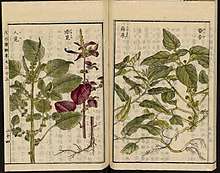Amaranthus tricolor
Amaranthus tricolor, known as edible amaranth,[3] is a species in the genus Amaranthus (family Amaranthaceae).
| Amaranthus tricolor | |
|---|---|
 | |
| Scientific classification | |
| Kingdom: | Plantae |
| Clade: | Tracheophytes |
| Clade: | Angiosperms |
| Clade: | Eudicots |
| Order: | Caryophyllales |
| Family: | Amaranthaceae |
| Genus: | Amaranthus |
| Species: | A. tricolor |
| Binomial name | |
| Amaranthus tricolor | |
| Synonyms[1] | |
|
List
| |
The ornamental plant is known as bireum in Korea;[3] tampala, tandaljo, or tandalja bhaji in India;[4] callaloo in the Caribbean; and Joseph's coat after the Biblical figure Joseph, who is said to have worn a coat of many colors. Although it is native to South America, many varieties of amaranth can be found across the world in a myriad of different climates due to it being a C4 carbon fixation plant, which allows it to convert carbon dioxide into biomass at a more efficient rate than other plants. Cultivars have striking yellow, red, and green foliage.
Amaranthus gangeticus
Amaranthus gangeticus is considered a synonym of A. tricolor,[5] but has been recognized as a separate species in the past. A. gangeticus is also known as elephant-head amaranth. It is an annual flowering plant with deep purple flowers. It can grow to 2–3 feet (0.61–0.91 m) tall. In Bangladesh, it has been used as a leafy vegetable. It may inhibit calcium retention in rice-based diets.[6]
Culinary uses

The leaves and stems may be eaten as a salad vegetable. In Africa, it is usually cooked as a leafy vegetable.[7] It is usually stir fried or steamed as a side dish in both China and Japan.
China
In China, it is referred to as sweat vegetable, because it ripens in the summer, and people would be sweating when they eat it.
Korea
In Korea, the plant is referred to as bireum (비름). Small-leaved, reddish-stalked chambireum (참비름, "true bireum") is used as a namul vegetable in Korean cuisine. Considered a san-namul (wild green) that grows abundantly in the countryside, it tends to be foraged rather than planted and harvested.[8] It has an earthy and nutty flavor, and goes well with both gochujang- and soup soy sauce-based seasonings, and bori-bap (barley rice).[8][9]
 Bireum-namul (seasoned edible amaranth)
Bireum-namul (seasoned edible amaranth)
In culture
It appears on the coat of arms of Gonville and Caius College, Cambridge, where it is called "flowers gentle".
References
- "The Plant List: A Working List of All Plant Species".
- "Amaranthus melancholicus". Germplasm Resources Information Network (GRIN). Agricultural Research Service (ARS), United States Department of Agriculture (USDA). Retrieved 2013-08-14.
- English Names for Korean Native Plants (PDF). Pocheon: Korea National Arboretum. 2015. p. 349. ISBN 978-89-97450-98-5. Archived from the original (PDF) on 25 May 2017. Retrieved 6 December 2016 – via Korea Forest Service.
- Michel H. Porcher. "Sorting Amaranthus names".
- "Amaranthus gangeticus L." The Plant List. 2010. Retrieved 9 March 2013.
- Larsen, T.; Thilsted, S. H.; Biswas, S. K.; Tetens, I. (2007). "The leafy vegetable amaranth (Amaranthus gangeticus) is a potent inhibitor of calcium availability and retention in rice-based diets". British Journal of Nutrition. 90 (3): 521–527. doi:10.1079/BJN2003923. PMID 13129457.
- Grubben, G.J.H. & Denton, O.A. (2004) Plant Resources of Tropical Africa 2. Vegetables. PROTA Foundation, Wageningen; Backhuys, Leiden; CTA, Wageningen.
- Bburi Kitchen (20 April 2016). "10 Korean spring greens you should know". Stripes Korea. Archived from the original on 20 December 2016. Retrieved 15 December 2016.
- 정, 운헌 (6 March 2013). "박정희와 비름나물" [Park Chung-hee and bireumnamul]. Kangwon Dominilbo (in Korean). Retrieved 15 December 2016.
| Wikimedia Commons has media related to Amaranthus tricolor. |
| Wikispecies has information related to Amaranthus tricolor |
External links
- PROTAbase on Amaranthus tricolor
- "Amaranthus tricolor" at the Encyclopedia of Life
- Amaranthus tricolor L. Medicinal Plant Images Database (School of Chinese Medicine, Hong Kong Baptist University) (in Chinese) (in English)